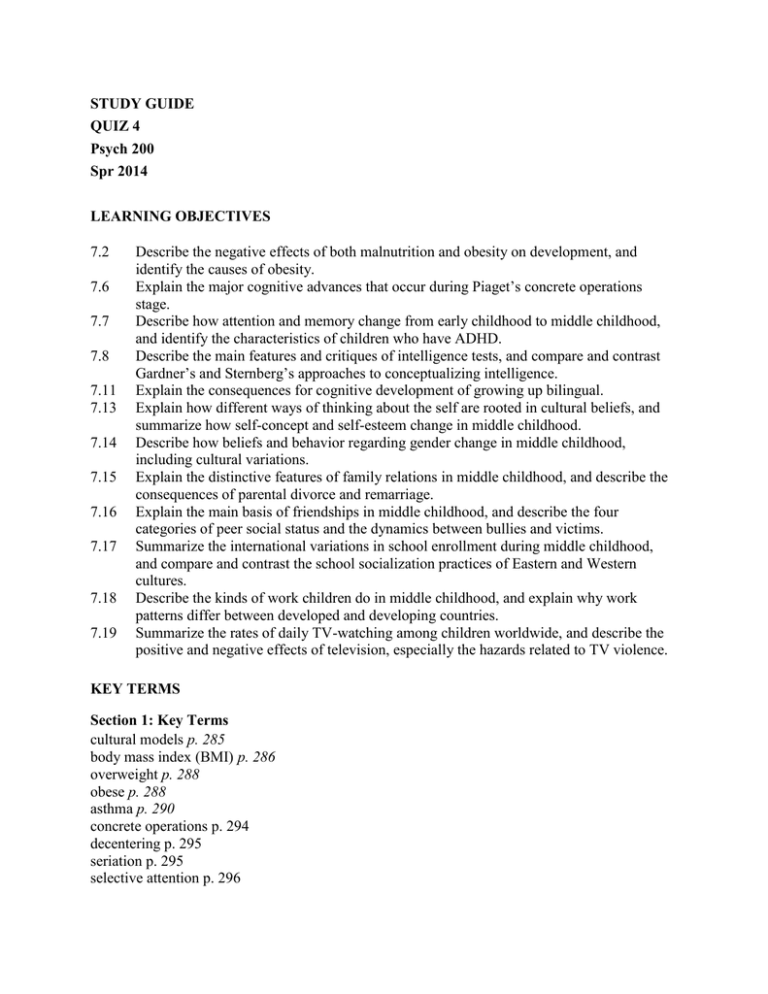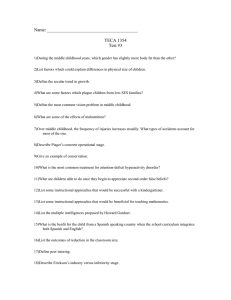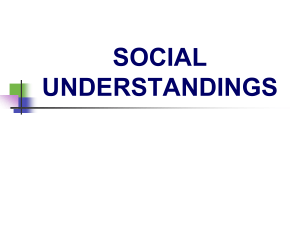STUDY GUIDE QUIZ 4 Psych 200 Spr 2014
advertisement

STUDY GUIDE QUIZ 4 Psych 200 Spr 2014 LEARNING OBJECTIVES 7.2 7.6 7.7 7.8 7.11 7.13 7.14 7.15 7.16 7.17 7.18 7.19 Describe the negative effects of both malnutrition and obesity on development, and identify the causes of obesity. Explain the major cognitive advances that occur during Piaget’s concrete operations stage. Describe how attention and memory change from early childhood to middle childhood, and identify the characteristics of children who have ADHD. Describe the main features and critiques of intelligence tests, and compare and contrast Gardner’s and Sternberg’s approaches to conceptualizing intelligence. Explain the consequences for cognitive development of growing up bilingual. Explain how different ways of thinking about the self are rooted in cultural beliefs, and summarize how self-concept and self-esteem change in middle childhood. Describe how beliefs and behavior regarding gender change in middle childhood, including cultural variations. Explain the distinctive features of family relations in middle childhood, and describe the consequences of parental divorce and remarriage. Explain the main basis of friendships in middle childhood, and describe the four categories of peer social status and the dynamics between bullies and victims. Summarize the international variations in school enrollment during middle childhood, and compare and contrast the school socialization practices of Eastern and Western cultures. Describe the kinds of work children do in middle childhood, and explain why work patterns differ between developed and developing countries. Summarize the rates of daily TV-watching among children worldwide, and describe the positive and negative effects of television, especially the hazards related to TV violence. KEY TERMS Section 1: Key Terms cultural models p. 285 body mass index (BMI) p. 286 overweight p. 288 obese p. 288 asthma p. 290 concrete operations p. 294 decentering p. 295 seriation p. 295 selective attention p. 296 attention-deficit/hyperactivity disorder (ADHD) p. 297 mnemonics p. 298 rehearsal p. 298 organization p. 298 elaboration p. 298 intelligence p. 299 intelligence quotient (IQ) p. 300 normal distribution p. 301 Flynn effect p. 302 theory of multiple intelligences p. 303 triarchic theory of intelligence p. 303 phonics approach p. 304 whole-language approach p. 305 dyslexia p. 305 learning disability p. 305 bilingual p. 307 metalinguistic skills p. 308 multilingual p. 309 CHAPTER 8: ADOLESCENCE LEARNING OBJECTIVES 8.2 8.3 8.4 8.6 8.8 8.9 8.10 8.12 8.13 8.14 Describe the normative timing of pubertal events, cultural variations, and how being early or late influences emotional and social development. Identify the main gender differences in puberty rituals worldwide. Describe the prevalence, symptoms, and treatment of eating disorders. Explain the features of hypothetical-deductive reasoning and give an example of how it is assessed. Summarize the major changes in attention and memory that take place from middle childhood to adolescence. Define the imaginary audience and the personal fable and explain how they reflect egocentrism in adolescence. Produce an example of the zone of proximal development and scaffolding involving adolescents. Describe how self-understanding, self-concept, and self-esteem change during adolescence. Compare and contrast the cultural patterns in gender expectations for girls and boys in adolescence. Discriminate between Kohlberg’s theory of moral development and Jensen’s worldviews theory. 8.15 8.16 8.17 8.18 8.19 8.20 8.21 8.22 8.24 Describe the cultural variations in religious beliefs during adolescence as well as the sources and outcomes of religiosity within cultures. Summarize the cultural variations in adolescents’ relationships with parents, siblings, and extended family. Describe cultural variations in adolescents’ relationships with friends, and characterize their interactions with peers. Identify cultural variations in adolescent love and sexuality, including variations in adolescent pregnancy and contraceptive use. Compare and contrast the secondary education systems and academic performance of developed countries and developing countries. Summarize the typical forms of adolescent work in developing countries and developed countries, and describe the features of apprenticeships in Europe. Explain the function of media use in adolescents’ lives and apply the Media Practice Model to the playing of electronic games. Summarize the explanations for why age and crime are so strongly correlated, and describe the multisystemic approach to combating delinquency. Define resilience and name the protective factors that are related to resilience in adolescence. KEY TERMS Section 1 Key Terms puberty p. 341 adolescence p. 341 primary sex characteristics p. 343 secondary sex characteristics p. 343 menarche p. 343 spermarche p. 343 secular trend p. 345 puberty ritual p. 347 anorexia nervosa p. 350 bulimia p. 350 self-medication p. 353 formal operations p. 355 hypothetical-deductive reasoning p. 355 adolescent egocentrism p. 359 imaginary audience p. 359 personal fable p. 359 preconventional reasoning p. 368 conventional reasoning p. 368 postconventional reasoning p. 368 worldview p. 369 cyberbullying p. 377 homophobia p. 380




